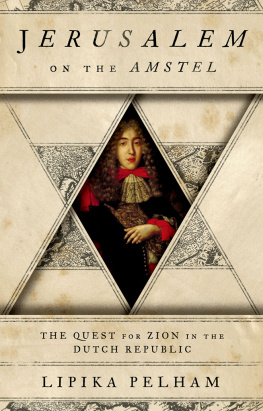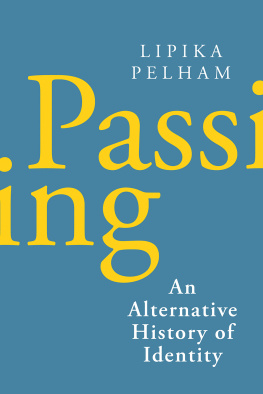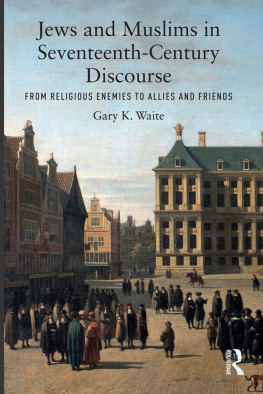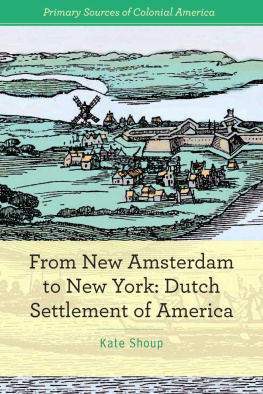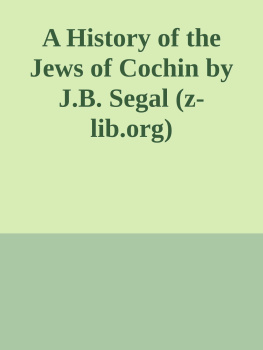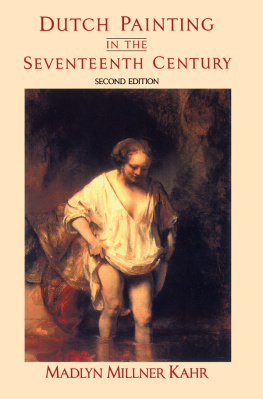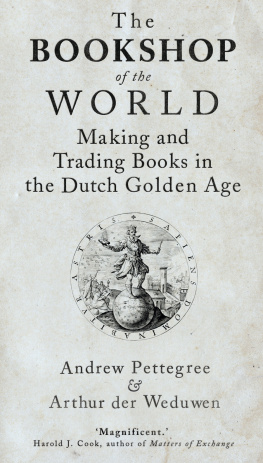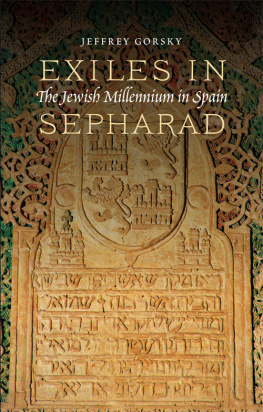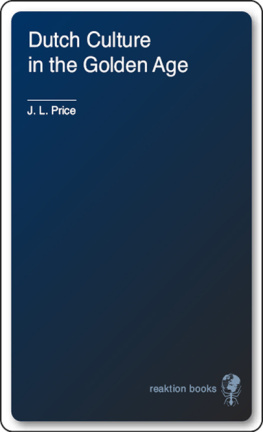LIPIKA PELHAM
Jerusalem on the Amstel
The Quest for Zion in the Dutch Republic

HURST & COMPANY, LONDON
First published in the United Kingdom in 2019 by
C. Hurst & Co. (Publishers) Ltd.,
41 Great Russell Street, London, WC1B 3PL
Lipika Pelham, 2019
All rights reserved.
Distributed in the United States, Canada and Latin America by Oxford University Press, 198 Madison Avenue, New York, NY 10016, United States of America.
The right of Lipika Pelham to be identified as the author of this publication is asserted by her in accordance with the Copyright, Designs and Patents Act, 1988.
A Cataloguing-in-Publication data record for this book is available from the British Library.
ISBN: 9781787381841
The chapter epigraphs from Philip Polacks verse translation of Rehuel Jessuruns Dilogo dos Montes (Tamesis Books, 1975) are reproduced with the kind permission of Michael Polack.
www.hurstpublishers.com
For Val
CONTENTS
PART I
AN END TO WANDERING
PART II
FROM RICHES TO RAGS
The author and the publisher thank Ets Haim Library (EH) and the Jewish Historical Museum (JHM) in Amsterdam for their help in reproducing many of the figures illustrating this book.
1. Title page of Rehuel Jessuruns Dialogo dos Montes (EH).
2. De Hooghes Hof van den Baron Belmonte (JHM).
3. De Hooghes Jewish funeral near Amsterdam (JHM).
4. Page from Saul Levi Morteiras sermons (EH).
5. and 6. Title pages showing Menasseh ben Israels printing press stamp (EH).
7. Menasseh ben Israels ceremonial pamphlet celebrating the royal visit to the Esnoga (EH).
8. Inaugural plaque of Amsterdam Town Hall. Public domain (Wikicommons).
9. Letter by 24 members of Yeshuot Meshiho to hail Shabtai Tzvi as Messiah (EH).
10. Berckheydes View of the Great and Portuguese Synagogues in Amsterdam (JHM).
11. De Hooghes Glory of the Amstel and its Senate (JHM).
12. De Hooghes Portuguese Synagogue in Amsterdam during the inauguration (JHM).
13. Cohanim golden washbasin (JHM).
14. Phoenix seal of the United Congregation of Talmud Torah. Authors photo.
15. Rembrandts Ephraim Bueno, Jewish Physician. Now held at the Metropolitan Museum of Art, New York (public domain).
16. Rembrandts Moses Breaking the Tablets of the Law. Now held in the Gemldegalerie, Berlin (public domain).
17. Rembrandts illustrations to Menasseh ben Israels Piedra gloriosa. Now held at the British Museum, London (public domain).
18. Hendrik Jacob Curiel with his wife Apalonia Curiel-Jiskoot. Reproduced with kind permission of the Curiel family.
19. Newspaper article reporting Hendrik Jacobs NSB record and sentence. Public domain.
20. Death, on a tombstone in Beth Haim cemetery. Authors photo.
21. Jacobs dream, on a tombstone in Beth Haim cemetery. Authors photo.
22. The hand of God cutting down the Tree of Life, on a tombstone in Beth Haim cemetery. Authors photo.
In early 2017, Richard McIlroy from the BBC World Services Heart and Soul asked me to look into a possible programme on 500 years of the Reformation, from a Jewish angle. I am grateful to Richard for inadvertently directing me to the realm of research that would consume me by the summer of that year, when I found myself renting a flat in Amsterdam with two of my children, close to the old Jodenbuurt (Jewish Quarter).
I would like first of all to thank Sara and Arun, for putting up with their mother pursuing a frenzied obsession with the incredible epoch of the birth of Sephardi Judaism in Amsterdam. I spent my time researching at Ets Haim, the oldest still-functioning Jewish library; it dates back to the seventeenth century, when Iberian New Christians arrived in Amsterdam and reclaimed their Jewish heritage. Their admission to the northern European city was a revolutionary byproduct of the Protestant Reformation. But by now, I was working on a book, not a BBC programme.
Michael Dwyer of Hurst Publishers said he believed in the book idea, after I wrote to him with a synopsis and my enthusiasm. I was thrilled. When we finally met after he had read the first five or so chapters, he said, It seems youve been ordained to write this book. The Judaism of the Sephardim has been very close to my heart for most of my life, having first heard about their long odyssey from Val, my Cairo-born mother-in-law, who spent her childhood in Alexandria.
I cannot thank enough my husband, Nico, to whom I owe most of my natural induction to the world of Maimonides in Crdoba, Fez and Cairo. Since we met in our early twenties, Ive been on an intoxicating journey with him, to retrace the old world where Sephardi Jews and Muslims lived in harmony for hundreds of years until the fall of Granada in 1492.
Somehow this search for the legacy of a centuries-old ArabJewish entente has linked me with Yossi Babila, the Iraqi-Jewish-origin security guard at Amsterdams Portuguese Synagogue. On a Shabbat evening in August 2017, I arrived at the magnificent Esnoga with my children and asked in Hebrew if we could join the service. Yossi looked hesitantly at first at these unlikely guests for Friday night prayers, before opening the door. Soon Yossi was talking to me about his names Arabic rootBab means gate, and he was indeed the gatekeeper.
As luck would have it, I was invited to stay during my research trips to Amsterdam in Yossi Babilas converted attic flat inside one of the tall, narrow seventeenth-century houses that surround the synagogue. From my window, I watched 1,000 candles being lit in the Esnoga on the eve of Yom Kippur in 2017, a service that I joined, mesmerised by the power and beauty of the Portuguese Jewish liturgy. In 1603, it was the Yom Kippur service held in a harbourside house that marked the re-entry into Judaism of a group of Iberian Catholic immigrants.
I am immensely grateful to Bart Wallet for sharing his rich insight into the early days of the Portuguese Jewish community in Amsterdam as we sat in his office at the University of Amsterdam, near the historic waterfront. The research for this book also would not have been possible without the advice, contacts and enthusiasm of Heide Warncke, curator of Ets Haim Library. Heide always left my requested manuscripts ready for me on the central desk whenever I wanted to visit.
Tirtsah Levie Bernfeld has been guiding me throughout the writing of the book, including going through fact-checking of certain passages during final edit. She was always available to talk; I even got replies late at night after I sent urgent queries. Tehila Joucovitzky first told me about the Sabbateans and the Turkish messiah Shabbatai Zvi, when I stayed at her Arlozorov flat in Tel Aviv. Hami Verbin, one of my oldest and dearest friends in Jerusalem, has given me invaluable research tips.
I am privileged to have known and spent time with Professor Ludo Abicht in Antwerp. Without his mugs of coffee during a jittery summer afternoon in 2017, I would not fully have been able to grasp the break-up of the Spanish Netherlands. I would also like to thank Abraham Palache, a descendant of the Portuguese Jews in Amsterdam, who was my first reader and who enthusiastically approved of my passion and efforts in an ambitious project to link the seventeenth century and the Portuguese Jewish presence in Amsterdam today.
Julie-Marthe Cohen from Amsterdams Jewish Historical Museum offered important contacts and invited me to Jews and the House of Orange: 400 years of history, a sumptuous gathering at the Portuguese Synagogue in Amsterdam in spring 2018, attended by the Dutch king. Her colleague Anton Kras sent me the beautiful images of engravings and paintings from the museums collection. I was fascinated by my conversation with Mirjam Knotter, and the idea that Rembrandt might have been an ordinary artist who chanced upon his extraordinary, exotic neighbours in the Jodenbuurt.

